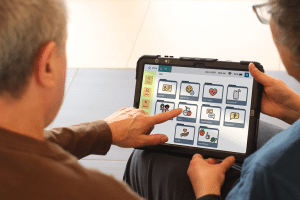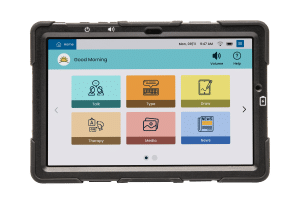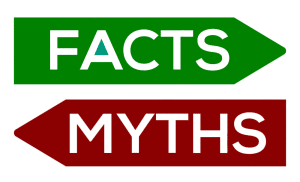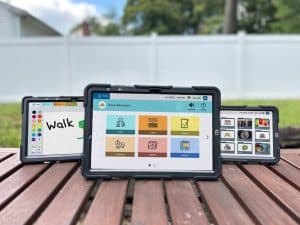From simple gestures to advanced speech-generating devices (SGDs), AAC can help us share our thoughts, emotions, and ideas in ways that work for us.
What does AAC stand for?
Augmentative
Alternative
Communication
AAC means Augmentative and Alternative Communication. It encompasses tools, techniques, and systems designed to help individuals with speech or language challenges express themselves. These solutions range from simple picture boards to advanced speech-generating devices (SGDs). At Lingraphica, we believe communication is a basic human right, and AAC empowers people to connect with loved ones, share their stories, and engage fully with the world.
Talk With Us About Your Communication Needs
Why Is AAC Important?
AAC changes lives by breaking down communication barriers. It:
- Encourages Independence: Communicate needs, wants, and preferences.
- Builds Connections: Strengthen relationships with family, friends, and caregivers.
- Opens Opportunities: Support educational, professional, and social goals.
- Reduces Frustration: Minimize stress caused by communication challenges.

With AAC tools, including high-tech speech devices, individuals can find new ways to communicate and connect with others.
Types of AAC Systems
Unaided AAC
These rely on natural communication methods, such as:
- Gestures and Facial Expressions: Express meaning through body language.
- Sign Language: Use structured hand movements to convey thoughts.
People around the world rely on no-tech AAC daily and likely don’t even realize it. A wave hello, a thumbs-up, a pointing finger — all AAC.


Aided AAC
Aided AAC utilizes external tools for communication:
- Low-Tech AAC:
- Communication Boards: Point to pictures or symbols to share ideas.
- Alphabet Boards: Spell out words with letters.
- High-Tech AAC:
- Speech-Generating Devices (SGDs): Advanced tools like Lingraphica’s customizable solutions.
- AAC Apps: Mobile apps designed for communication on tablets and smartphones.
Who Can Benefit from AAC?
AAC is for anyone who faces challenges with spoken communication, including:
- Neurological Conditions: Autism, cerebral palsy, ALS, or aphasia.
- Developmental Disabilities: Cognitive or speech impairments.
- Acquired Conditions: Stroke, traumatic brain injuries, or degenerative diseases like Parkinson’s.
Whether using low-tech aids or high-tech speech-generating devices, AAC provides a pathway to clearer communication and fuller participation in life.
How to Choose the Right AAC System
Choosing the best AAC system involves:
- Abilities: Assess motor skills, vision, and cognitive strengths.
- Goals: Address both immediate and long-term communication needs.
- Environment: Tailor the system to fit home, school, or work settings.
- Usability: Ensure the device is intuitive for users and caregivers alike.

Lingraphica offers free device trials, expert consultations, and lifetime support to guide you in finding the right AAC solution.
Debunking Common AAC Myths

Myth: AAC is only for non-speaking individuals.
Fact: AAC benefits anyone with communication challenges, even those who speak at times.
Myth: Using AAC hinders speech development.
Fact: Research shows AAC often enhances speech and language abilities.
Myth: AAC systems are difficult to use.
Fact: Modern AAC tools, including Lingraphica’s speech devices, are designed to be user-friendly and accessible.
Real Stories, Real Impact
AAC solutions, like speech-generating devices, have transformed countless lives:
- Karen: “My device gives me independence that I did not have before.” Click here to read Karen’s story
- Joe: “Now I can be a part of a conversation, not just a piece of furniture.” Click here to read Joe’s story
- And many more!

What is AAC? FAQs About AAC
What does AAC stand for?
AAC stands for Augmentative and Alternative Communication, a field focused on tools and systems to support or replace natural speech. Augmentative meaning a way to add to or supplement speech,” and Alternative meaning, “a way to replace speech.”
What are examples of AAC devices?
AAC devices typically refer to high-tech solutions like Lingraphica’s speech-generating devices (SGDs). However, the term also encompasses low-tech options, such as communication boards and letter charts.
How does AAC improve communication?
AAC provides alternative ways to share thoughts, needs, and emotions, enhancing quality of life and reducing frustration.
Are AAC systems customizable?
Yes! Lingraphica devices can be tailored with personalized words, images, and voices to meet individual needs.
How can AAC systems be funded?
Many AAC systems, including Lingraphica’s speech devices, are often covered by Medicare, Medicaid, and private insurance. Grants and flexible payment options are also available. Click here to learn more about funding options.
Take the Next Step
AAC provides a powerful bridge to independence, connection, and communication. Discover how Lingraphica’s innovative AAC tools, including speech-generating devices, can transform your journey today.


